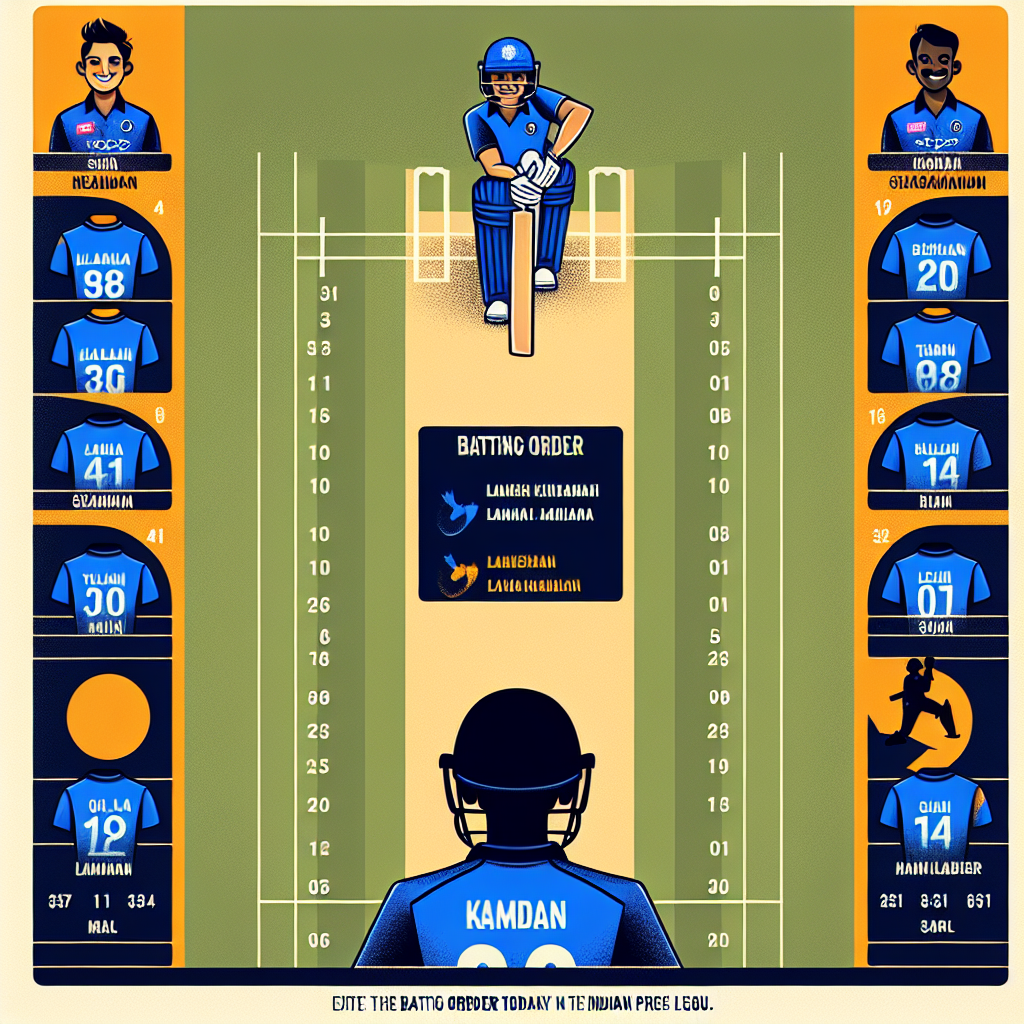Understanding the IPL Batting Order: Strategies and Insights

The Indian Premier League (IPL) is not just a cricket tournament; it’s a festival that brings together the best cricketing talents from around the world. One of the most intriguing aspects of the game is the batting order, which can significantly influence the outcome of a match. In this article, we delve into the intricacies of the IPL batting order, exploring strategies, case studies, and statistics that highlight its importance in today’s matches.
The Importance of Batting Order in IPL
The batting order in cricket, particularly in the IPL, is a strategic element that can make or break a team’s performance. It involves deciding which player bats at which position, and this decision is influenced by several factors, including the players’ form, the opposition’s strengths and weaknesses, and the match situation.
- Player Form: A player in good form is often promoted up the order to maximize their impact.
- Opposition Analysis: Teams analyze the opposition’s bowling attack to decide the best batting order.
- Match Situation: The required run rate and the number of overs left can dictate changes in the batting order.
Strategies Behind the Batting Order
Teams employ various strategies when deciding their batting order. These strategies are often tailored to the specific conditions of the match and the strengths of the players.
1. The Anchor Strategy
In this strategy, a team places a reliable batsman at the top of the order to anchor the innings. This player is expected to play through the innings, providing stability while others play more aggressively around them. For example, players like Virat Kohli and Kane Williamson have often played this role for their respective teams.
2. The Aggressive Start
Some teams prefer to start with aggressive batsmen who can take advantage of the fielding restrictions in the powerplay overs. This approach aims to set a strong foundation by scoring quickly in the initial overs. The likes of Chris Gayle and David Warner have been known for their explosive starts.
3. The Flexible Middle Order
Flexibility in the middle order allows teams to adapt to different match situations. Players who can accelerate the scoring rate or stabilize the innings as needed are crucial in this role. Teams often rotate players like AB de Villiers and Jos Buttler in these positions based on the match context.
4. The Finisher Role
The finisher is a player who can close out the innings with a flurry of runs, often under pressure. This role requires a calm temperament and the ability to hit big shots. MS Dhoni and Kieron Pollard are prime examples of successful finishers in the IPL.
Case Studies: Successful Batting Orders in IPL History
To understand the impact of a well-planned batting order, let’s look at some successful case studies from IPL history.
Chennai Super Kings (CSK) – 2018
In 2018, CSK’s batting order was a perfect blend of experience and youth. The team relied on Shane Watson and Ambati Rayudu to provide explosive starts, while Suresh Raina and MS Dhoni anchored the middle order. The flexibility of their batting order allowed them to chase down challenging targets, leading to their third IPL title.
Mumbai Indians (MI) – 2020
Mumbai Indians’ success in 2020 was largely due to their dynamic batting order. Quinton de Kock and Rohit Sharma provided solid starts, while Suryakumar Yadav and Ishan Kishan adapted to different situations in the middle order. The presence of Hardik Pandya and Kieron Pollard as finishers ensured that MI could accelerate in the death overs, securing their fifth IPL title.
Statistics: The Impact of Batting Order on Team Performance
Statistics provide valuable insights into how batting order affects team performance in the IPL. Here are some key statistics that highlight its importance:
- Powerplay Performance: Teams that score more than 50 runs in the powerplay have a higher win percentage, emphasizing the importance of a strong start.
- Middle Overs Stability: Maintaining a steady run rate without losing wickets in the middle overs often leads to successful chases.
- Death Overs Acceleration: Teams that score at a rate of over 10 runs per over in the last five overs have a significant advantage in setting or chasing targets.
Challenges in Deciding the Batting Order
While the batting order is crucial, it also presents several challenges for team management and captains.
1. Balancing Aggression and Stability
Finding the right balance between aggressive and stable batsmen is a constant challenge. Teams must ensure that they have enough firepower to capitalize on scoring opportunities while maintaining stability to avoid collapses.
2. Adapting to Changing Conditions
Pitch conditions and weather can change rapidly, affecting the effectiveness of certain batting strategies. Teams need to be adaptable and ready to alter their batting order based on these changes.
3. Managing Player Expectations
Players often have preferred batting positions, and managing their expectations while prioritizing team strategy can be challenging. Effective communication and leadership are essential in this regard.
Conclusion: The Art and Science of IPL Batting Order
The IPL batting order is a complex blend of art and science, requiring strategic planning, adaptability, and a deep understanding of the game. Successful teams are those that can effectively balance aggression with stability, adapt to changing conditions, and leverage the strengths of their players. As the IPL continues to evolve, so too will the strategies surrounding the batting order, making it an ever-fascinating aspect of the game.
In conclusion, the batting order is not just about who bats when; it’s about maximizing a team’s potential and outsmarting the opposition. As fans and analysts, understanding these nuances adds a layer of appreciation for the game and the strategic brilliance that unfolds on the field.